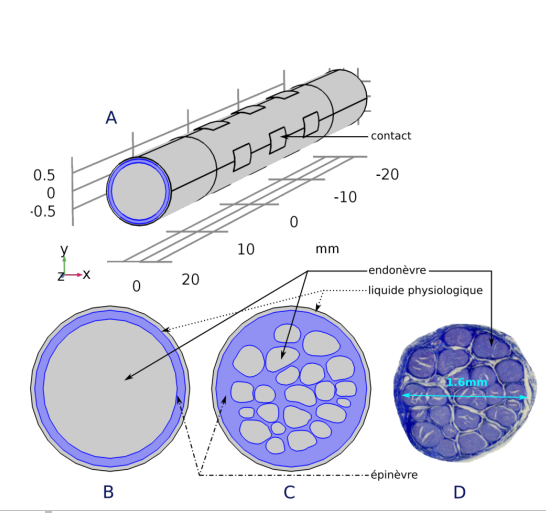Section: New Results
Model based optimal multipolar stimulation without a priori knowledge of nerve structure: application to vagus nerve stimulation
Participants : Mélissa Dali, Olivier Rossel, David Guiraud.
Neural electrical stimulation, applied to the peripheral nervous system for motor functions restoration or neuromodulation, is a thriving technology, especially implanted stimulation using cuff electrodes positioned around a peripheral nerve. The main obstacle to the development of stimulation systems is the difficulty in obtaining the independent stimulation or inhibition of specific target functions (i.e. functional selectivity). The parameters involved in selectivity are not always intuitive and the number of degrees of freedom (choice of electrode, number of contacts, pulse shape etc.) is substantial. Thus, testing all these hypotheses in a clinical context is not conceivable. This choice of parameters can be guided using prior numerical simulations predicting the effect of electrical stimulation on the neural tissue. Numerous studies developed new strategies to achieve selectivity based on modeling results that have been validated a posteriori by experimental works. We presented a general method based on a spatiotemporal model to optimize and assess multipolar neural electrical stimulation without a priori knowledge of the nerve structure. The model consists of two independent components: a lead field matrix (LFM) and an activation model. It represents the transfer function from the applied current to the extracellular voltage present on the nodes of Ranvier along each axon. The determination of fibers activation is used to optimize the spatial layout for the selective activation of specific fibers or nerve areas. Optimization is not only based on selectivity but also on robustness and efficiency of the stimulation settings.
The results show that state-of-the- art solutions are part of the optimized solutions but new ones can emerge depending on the trade-off between the criteria and the targeted area. We successfully assessed the solutions in-vivo to selectively induce a decrease in cardiac rhythm through vagus nerve stimulation. Experiments on animal model allowed us to evaluate the effectiveness and genericness of the method. These encouraging results suggest that this approach will have broader applications that would benefit from multicontact cuff electrodes to elicit very accurate and selective responses. This work was performed as part of a larger project on vagus nerve stimulation (INTENSE project) in which one of the applications focused on the treatment of cardiac disorders. The main objective was to selectively activate a specific population of nerve fibers to improve therapy and decrease side effects. Within the framework of the INTENSE project, the second application investigated vagus nerve stimulation as a therapy for morbid obesity. Activation of target axons related to gastric functions requires a significant amount of charge injection. Several studies suggest that non-rectangular waveforms can activate axons of the peripheral nervous system with a reduced amount of charge compared to the reference rectangular pulse shape. Our last contribution focuses on the experimental study and the modeling of these complex waveforms. The modeling approach, if performed properly and while bearing in mind its limits, provides a relevant and even indispensable analysis tool for the clinical adjustment of neuroprostheses.


